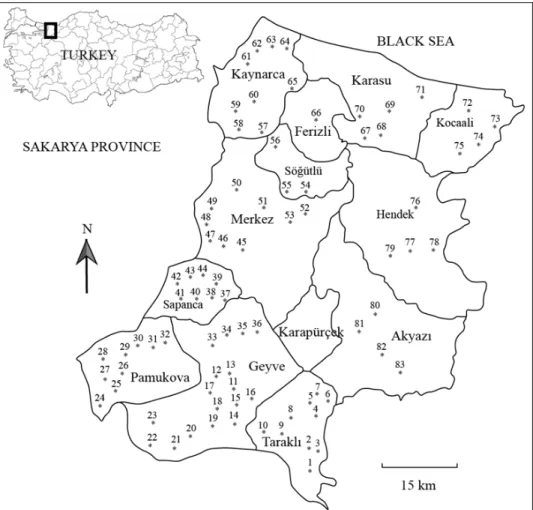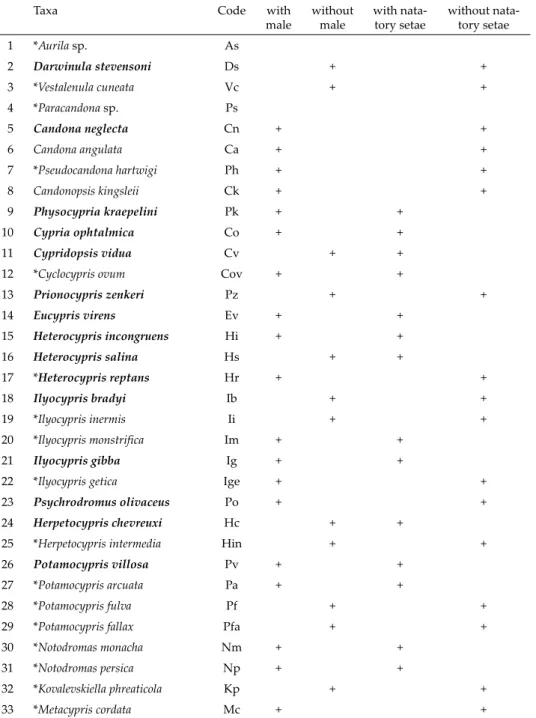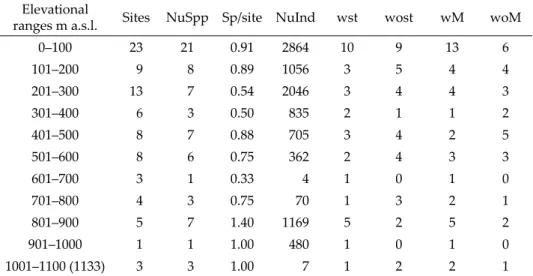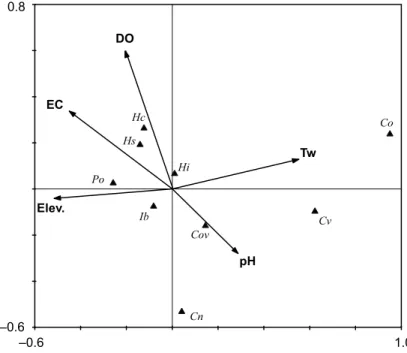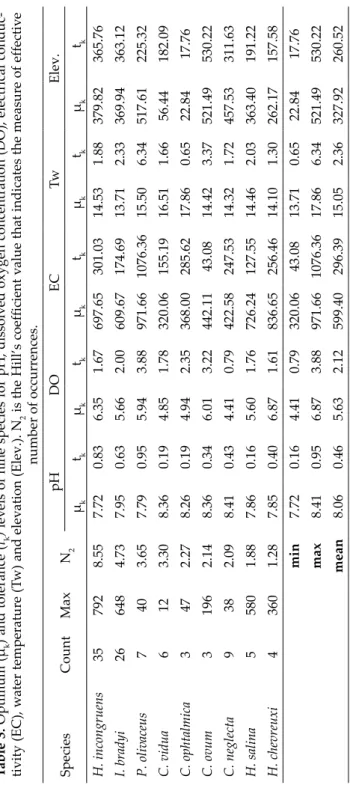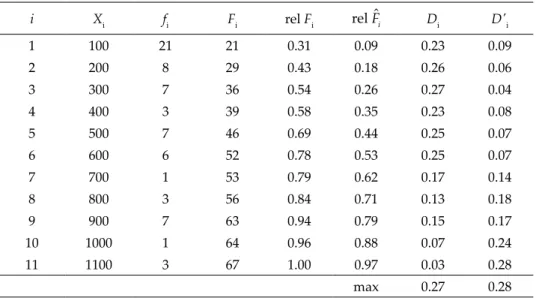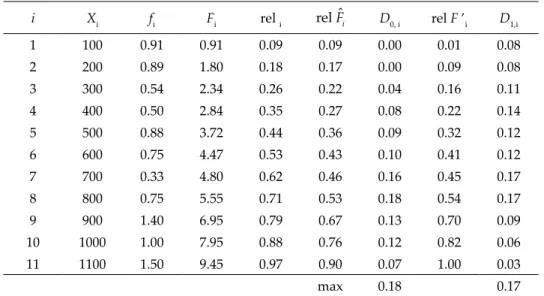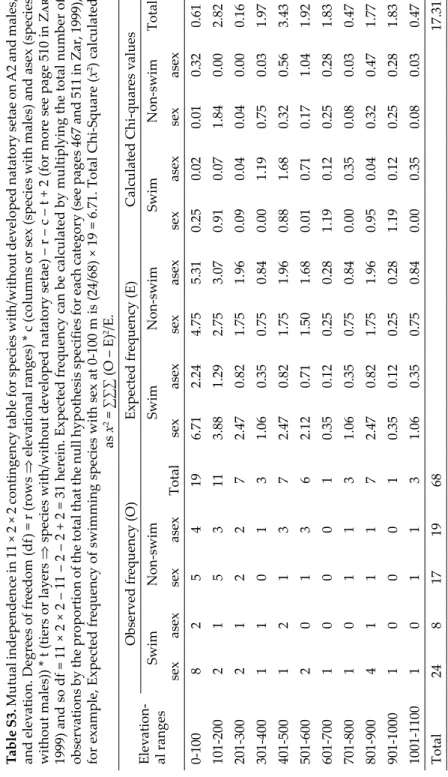ON THE RELATIONSHIP BETWEEN THE OCCURRENCE OF OSTRACOD SPECIES AND ELEVATION
IN SAKARYA PROVINCE, TURKEY
Mehmet Yavuzatmaca1, Okan Külköylüoğlu1, Derya Akdemİr2 and Ebru Çelen1
1Department of Biology, Faculty of Arts and Science, Abant İzzet Baysal University, Bolu, Turkey E-mails: yavuzatmaca46@gmail.com, okankul@gmail.com, celen_e@ibu.edu.tr
2Merdivenköy Mah.¸ Şair Arşi Cad. No: 16/14, 34732, Kadıköy, İstanbul, Turkey E-mail: deryaakdemir@outlook.com.tr
In order to determine the distribution of ostracods species between sea level and 1133 m a.s.l. in the Sakarya Province of Turkey, 83 different aquatic sites were randomly sampled during 9–12 May, 2014. This sampling yielded a total of 9598 individuals belonging to 33 taxa (31 living). The species Vestalenula cuneata and Kovalevskiella phreaticola were new re- ports for Turkey. The number of species with males (19) and without males (12) tends to decrease with increasing elevation while there is no significant difference in the number of species per site. This corresponds to a decrease in the numbers of species with (14) and without (17) natatory setae on second antennae (A2). Accordingly, presence of species with/
without natatory setae on A2, with different reproductive modes, and numbers of species changed along with elevation seem to be all mutually independent in the population sam- pled. The first two axes of Canonical Correspondence Analysis explained 74.4% of relation- ships between species and environmental variables. Furthermore, two well-known cosmo- politan species (Heterocypris incongruens and Ilyocypris bradyi) were observed in almost all of the elevational ranges. Overall, these results support the prediction that elevation seems to have no direct influence on the presence of species with or without swimming setae in sexual or parthenogenetic populations. Results suggest that unlike non-cosmopolitan ostra- cods, species with cosmopolitan characteristics may not be limited by elevation.
Keywords: ostracod, Kolmogorov-Smirnov, elevation, distribution, tolerance.
INTRODUCTION
The main categories of biodiversity drivers were classified as climate (variation in abiotic variables), space (species–area relationship), evolution- ary history (speciation and extinction rates, clade age and phylogenetic niche conservatism) and biotic processes (ecotone effects, competition, mutualisms, habitat heterogeneity and habitat complexity) (McCaın & Grytnes 2010). Be- sides, the extinction risk of species is determined by the ecological and climatic limitations and also by the effect of elevation on their physiology (Şekercİoğlu et al. 2008). Thereby, the survival and occurrences of species depends on their ecological tolerance ranges (e.g., temperature) to different levels of environ- mental variables and their fluctuations caused by climate change (Thomas et al. 2004). Microclimatic changes in an area may be positively correlated with
elevation (Merrıam 1890, Stevens 1992). Reduction in air density and pres- sure with increasing elevation result in an air temperature decrease (Brown &
Gıbson 1983). This decrease in air temperature can eventually lower the water temperature. Indeed, gradual decrease of water temperature in the Tibetan region from 2668 to 5133 m a.s.l. was emphasized by Van der Meeren et al.
(2010). Similarly, Preud’homme & Stefan (1992) showed the response of water temperatures of lotic environments to air temperatures according to the depth of rivers. This phenomena is directly or indirectly affecting aquatic organ- isms by means of changing dissolved oxygen concentration and habitat loss (Lıvıngstone & Lotter 1998). This is because temperature is a deterministic factor for the geographic ranges of many aquatic and wetland species (Poff et al. 2002). Accordingly, fluctuation in physico-chemical variables of aquatic bodies related to water temperatures changes with the ascending or descend- ing of elevation (Reeves et al. 2007, Rogora et al. 2008) may affect the occur- rence and distribution of species (e.g., ostracods). In addition, Robınson et al.
(2008) indicated that elevation as a predictor variables of pH and nitrate (low pH and high nitrate at higher elevations) in Great Smoky Mountains National Park (U.S.A). In that case, species with wider tolerance levels to ecological variables and higher mutational ratios showed much more advantages for adapting to changing environments when we compared with others.
Ostracods are small (0.3–5 mm in length) bivalved microscopic organ- isms that are found in a variety of marine and non-marine aquatic bodies (Meısch 2000). They show a wide distribution in the world (Martens et al. 2008, 2013) by means of using active and/or passive distribution modes (Meısch 2000, Akdemİr et al. 2016). Small location change in the same habi- tat can be done actively with the aids of swimming setae of the individuals (Külköylüoğlu 2013). In contrast, dispersion can be achieved passively by different agents such as human, birds, fishes, wind (resting eggs), plants, am- phibians and insects to longer distance (McKenzıe & Moronı 1986, Horne &
Martens 1998, Fıguerola et al. 2003, Green et al. 2008, Vanschoenwınkel et al.
2008, Rodrıguez-Lazaro & Ruız-Muñoz 2012, Green 2016, Valls et al. 2016).
In addition to biotic factors, their distribution can also be depending and/or limited on abiotic (e.g., pH, elevation) factors. The effect of elevation is a long- term debate in the literature. Some studies stated that elevation was a limiting factor for ostracods (e.g., Mezquıta et al. 1999, Pıerı et al. 2009), zooplankton (Shehu et al. 2009) and avian species (Şekercİoğlu et al. 2008) but others (e.g., Laprıda et al. 2006, Külköylüoğlu et al. 2012a, Guo et al. 2013, Yavuzatmaca et al. 2015) did not support this idea. The elevational limitation of vectors (e.g., birds) that contributes to the dispersion of ostracods to long distance may al- low to any one say that elevation is a secondary factor (Martınez-Garcıa et al. 2015, Yavuzatmaca et al. 2015) limits the passive distribution of ostracods.
The controversy clearly outlines the fact that there is a need for future studies
dealing with relationships between the effect of elevation on the distribution and occurrence of ostracods. Hence, the main objective of study is to deter- mine the distribution of ostracods across an elevation range of 0-1133 m a.s.l.
in the Sakarya province of Turkey. Based on this main objective, we wanted to test the following hypotheses; i) Number of ostracod species are distributed uniformly from sea level to elevation of 1133 m a.s.l., ii) Numbers of ostracod species per site are distributed uniformly from sea level to elevation of 1133 m a.s.l., (in both (i and ii) hypotheses, we questioned how likely distribution of ostracod species (or species per site) from random observed data as specified in the null hypotheses) and iii) Occurrence of swimming setae on A2, pres- ence of bisexual population with males and changes in elevation ranges are all mutually independent in the population sampled.
MATERIAL AND METHODS Study area and sampling
Sakarya Province (40º17′-41º13′N, 29º57′–30º53′E, 4817 km2 of surface area) is located in the north east site of Marmara region of Turkey (Sakarya İKTM 2018). North side of the province is bordered by Black Sea. Total of 83 randomly selected sampling sites (one sample from each site) including seven different habitat types (spring, pond, pool, lake, slough, trough and creek) were visited once during 9–12 May of 2014 in Sakarya prov- ince (Fig. 1). We collected ostracod samples from about 1 m2 area with a maximum of 1 m depth from each site. To obtain the accurate value of environmental variables, water quality measurements were recorded before sampling. A YSI-Professional Plus was used to record dissolved oxygen concentration (DO, mg/L), percent oxygen saturation (%DO.), water temperature (Tw, °C), electrical conductivity (EC, μS/cm), pH, atmospheric pressure (mmHg) and oxidation-reduction potential (ORP, mV; measured directly from water). We recorded air temperature (°C) with a Testo 410-2 model anemometer while a GARMIN e- trex Vista H GPS was used to obtain geographical data (elevation, coordinates).
Sediments including ostracods were collected with a standard sized hand net (200 μm in mesh size) from the littoral region of lentic and slow flowing parts of lotic environ- ments. All collected samples were fixed with 70% of ethanol in 250 ml plastic bottles in situ to prevent the deterioration of ostracod specimens. In laboratory, ostracods samples washed and filtered through four standardized sieves (0.5, 1.0, 1.5 and 2.0 mm mesh size) under pressured water. Subsequently, the washed samples were put again into 250 ml plastic bottles and fixed with 70% ethanol for long term storage. Sorting of ostracods from the sediments were done under a stereomicroscope (Olympus ACH 1X) by using a pipette and dissecting needles. Taxonomic identification of species based on carapace morphology and dissecting soft body parts in lactophenol solution under a light microscope (Olym- pus BX-51) was done by following the taxonomic keys provided in Meısch (2000) and Karanovıc (2012). Scanning Electron Microscope (JEOL JSM-6390LV SEM) photograps of some species were taken at Abant İzzet Baysal University. Ostracod samples can be avail- able upon request and that are stored at the Limnology Laboratory of Abant İzzet Baysal University, Bolu, Turkey.
Statistical analysis
Kolmogorov-Smirnov (K-S) Goodness of Fit (D (test statistics) is the largest value of Di or D’i) and δ-corrected K-S Goodness of Fit (if n ≤ 25, D is the largest value of D0, i or D1,I) tests (Lıllıefors 1967, Dallal & Wılkınson 1986, Zar 1999) were used to test the vertical distributions of ostracod species and species per site from sea level to 1133 m a.s.l. (for calculation of both tests see Supplementary Tables S1 and S2). If D > Dα, n reject null hy- pothesis (H0). A Chi-square analysis (Zar 1999) was used to test for mutual independence in three dimensional contingency table among elevation, occurrence of natatory setae on second antennae (A2) and presence of male (see Table S3). The range of elevation herein is 1133 and we broke this range into a number of equal elevational interval with a width of 100 m for these previous analyses. Therefore, the range is divided by width of intervals (1133/100 = 11.33) as a result 11 elevational intervals were created (see Tables 2 and S4, Note: one site above 1100 m included among the 1001–1100 m ranges). The ecological tol-
Fig. 1. Location of sampling sites in 13 counties of Sakarya province
Table 1. Taxa recorded in Sakarya province and species with/without males and A2 nata- tory setae. * represents new records for Sakarya province. Species names in bolditalics
show cosmopolitan distribution.
Taxa Code with
male without
male with nata-
tory setae without nata- tory setae
1 *Aurila sp. As
2 Darwinula stevensoni Ds + +
3 *Vestalenula cuneata Vc + +
4 *Paracandona sp. Ps
5 Candona neglecta Cn + +
6 Candona angulata Ca + +
7 *Pseudocandona hartwigi Ph + +
8 Candonopsis kingsleii Ck + +
9 Physocypria kraepelini Pk + +
10 Cypria ophtalmica Co + +
11 Cypridopsis vidua Cv + +
12 *Cyclocypris ovum Cov + +
13 Prionocypris zenkeri Pz + +
14 Eucypris virens Ev + +
15 Heterocypris incongruens Hi + +
16 Heterocypris salina Hs + +
17 *Heterocypris reptans Hr + +
18 Ilyocypris bradyi Ib + +
19 *Ilyocypris inermis Ii + +
20 *Ilyocypris monstrifica Im + +
21 Ilyocypris gibba Ig + +
22 *Ilyocypris getica Ige + +
23 Psychrodromus olivaceus Po + +
24 Herpetocypris chevreuxi Hc + +
25 *Herpetocypris intermedia Hin + +
26 Potamocypris villosa Pv + +
27 *Potamocypris arcuata Pa + +
28 *Potamocypris fulva Pf + +
29 *Potamocypris fallax Pfa + +
30 *Notodromas monacha Nm + +
31 *Notodromas persica Np + +
32 *Kovalevskiella phreaticola Kp + +
33 *Metacypris cordata Mc + +
erance (tk) and optimum (µk) values of species for different environmental variables were calculated by C2 software (Juggıns 2003) when Canonical Correspondence Analysis (CCA, after Detrended Correspondence Analysis) was performed by software package CANOCO for Windows 4.5 to explain the relationships between species and environmental variables (ter Braak 1987). In both (tolerance and optimum, and CCA) analyses, species with three or more occurrences were used. The levels of correlations among species, and environ- mental variables were calculated by a non-parametric Spearman Rank Correlation analysis (IBM-SPSS Statistics Version 21). In all analyses, adult individuals with complete soft body parts and carapaces were used while empty carapaces, valves and juveniles were omitted.
RESULTS
Total of 9598 individuals belonging to 33 taxa (31 recent and 2 sub-re- cent) were reported from 63 of 83 sampling sites (Table S4). In total, 19 of 31 species reproduce both sexually (males and females present) and parthe- nogenetically (only females present) but the rest show only parthenogenetic (without males) reproduction. More than half (11) of species with males have well developed A2 natatory setae (setae that at least reach the tips of the ter- minal A2 claws but reduced or undeveleoped setae do not reach beyond the base of the terminal claws) while 1/4 of species without males (3) have well developed natatory setae (see Table 1).
The number of species and species with/without males and natatory setae tend to fall when the elevational ranges increased from sea level to 1133 m a.s.l.
but only number of species per site showed a tendency to increase (see Table 2).
The hypothesis, “Number of ostracod species are distributed uniformly from sea level to elevation of 1133 m a.s.l.” was rejected (D = 0.28 (largest val- ue of Di or D’i) > D0.05(2),67 = 0.16). This means species number (fi) did not show a regular distribution when elevation increased (Table S1). Correspondingly, species number showed variability, such as, 21 species at 0–100 m, 7 species at 401–500 m, 3 species at 1001–1100 m.
In contrast to first hypothesis, “Number of ostracod species per site are distributed uniformly from sea level to elevation of 1133 m a.s.l.” was accept- ed (D = 0.18 (largest D0,i or D1,i) < D0.8 (Table) = 0.37). This means numbers of spe- cies per site did not show significant difference among increased elevational ranges (Table S2) even though sampling sites and encountered species num- ber fluctuations (e.g., 9 sites and 8 species at 101–200 m, 8 sites and 7 species at 401–500 m, 5 sites and 7 species at 801–900 m and for more see Table 2).
The last hypothesis “Occurrence of natatory setae on A2, presence of bi- sexual population with males and changes in elevational ranges are all mu- tually independent in the population sampled” meaning that there are no interactions either of three-way or two-way among of these variables was ac- cepted (Chi-square table(0.05, 31) = 44.99 > Chi-square (calculated) = 17.31, see Table S3).
Therefore, occurrence of natatory setae, presence of bisexual population and elevation are all mutually independent to each other, implying no direct effect of elevation on species distribution
The first two axes of CCA explained 74.40% of relationships between species and environmental variables with a variance of 6.10 (Table S5).
The used environmental variables (electrical conductivity (EC, P = 0.38, F = 0.87), water temperature (Tw, p = 0.43, F = 0.93), elevation (Elev., p = 0.55, F = 0.88), pH (p = 0.85, F = 0.40) and dissolved oxygen concentrations (DO, p = 0.72, F = 0.71) did not show significant effect on the distribution of ostracod species in Sakarya province. Four species (Herpetocypris chevreuxi, Heterocypris salina, Psychrodromus olivaceus and Ilyocypris bradyi) were situated on the left site of first axis where there are DO, EC and Elev. Remaining species (Hetero- cypris incongruens, Cypria ophtalmica, Cypridopsis vidua, Cyclocypris ovum, and Candona neglecta) were located at the site of Tw and pH and on the right site of axis 1. Of this species, C. ovum showed a close relationships with pH when H.
incongruens was relatively closer to the center of diagram (Fig. 2).
As seen in Table 3, especially cosmopolitan species (e.g., H. incong ruens, I.
bradyi, C. neglecta) had higher tolerance levels when we compared with others except C. ovum for elevation. This means such species have a wide range of el- evations. However, Cypria ophtalmica had lowest tolerance to elevation (17.76) and water temperature (0.65). Among the species H. chevreuxi had highest op- timum value (6.87) while C. neglecta had lowest tolerance value for dissolved
Table 2. Numbers of sampled sites (Sites), numbers of species (NuSpp), species per site (Sp/site), numbers of individuals (NuInd), species with (wst) or without (wost) natatory setae, and species with (wM) or /without (woM) males at 11 different elevational ranges
with 100 m interval.
Elevational
ranges m a.s.l. Sites NuSpp Sp/site NuInd wst wost wM woM
0–100 23 21 0.91 2864 10 9 13 6
101–200 9 8 0.89 1056 3 5 4 4
201–300 13 7 0.54 2046 3 4 4 3
301–400 6 3 0.50 835 2 1 1 2
401–500 8 7 0.88 705 3 4 2 5
501–600 8 6 0.75 362 2 4 3 3
601–700 3 1 0.33 4 1 0 1 0
701–800 4 3 0.75 70 1 3 2 1
801–900 5 7 1.40 1169 5 2 5 2
901–1000 1 1 1.00 480 1 0 1 0
1001–1100 (1133) 3 3 1.00 7 1 2 2 1
oxygen concentrations (Table 3). These optimum and tolerance levels of spe- cies to different ecological variables determine the occurrence of them in any kind of habitats and geographical regions.
There was a strong negative correlation between C. vidua and EC (rs = –0.88, n = 6, p < 0.05) when a strong positive correlation between P. olivaceus and Elev. (rs = 0.88, n = 7, p < 0.01). On the other hand, the remaining species did not show any significant correlations with the used environmental varia- bles. The correlations between environmental variables are like that pH-EC (rs
= –60, n = 58, p < 0.01), DO-Tw (rs = –0.49, n = 58, p < 0.01), DO-Elev. (rs = –0.54, n
= 58, p < 0.01) and Tw-Elev (rs = –0.71, n = 58, p < 0.01). In addition, the equation provied by trendline and R-square for the variables across elevational ranges are like for pH: y = 0.0242x + 8.0658 R2 = 0.1264; dissolved oxygen: y = 0.3209x + 4.6155 R2 = 0.6365; water temperature: y = –0.4479x + 16.27 R2 = 0.8528; air temperature: y= –0.4472x + 21.974 R2 = 0.3936 and for electrical conductivity:
y = –14.012x + 539.02 R2 = 0.1405. It seems that water and air temperatures and electrical conductivity had a tendency to decrease with the increase in eleva- tional ranges while pH and dissolved oxygen concentration had a propensity to ascend.
–0.6
–0.6 1.0
0.8
Cn
Co
Cv Cov
Hi Hs
Ib Po
Hc
pH DO
EC
Tw
Elev.
Fig. 2. Ordination of nine species according to the effect of electrical conductivity (EC), dissolved oxygen concentration (DO), elevation (Elev.), pH and water temperature (Tw) on CCA diagram. Abbreviations for species: Candona neglecta (Cn), Cypria ophtalmica (Co), Cyclocypris ovum (Cov), Cypridopsis vidua (Cv), Heterocypris incongruens (Hi), H. salina (Hs),
Herpetocypris chevreuxi (Hc), Ilyocypris bradyi (Ib) and Psychrodromus olivaceus (Po)
Table 3. Optimum (μk) andtolerance (tk) levels of nine species for pH, dissolved oxygen concentration (DO), electrical conduc- tivity (EC), water temperature (Tw) and elevation (Elev.). N2 is the Hill’s coefficient value that indicates the measure of effective number of occurrences. SpeciesCountMaxN2pHDOECTwElev. μktkμktkμktkμktkμktk H. incongruens357928.557.720.836.351.67697.65301.0314.531.88379.82365.76 I. bradyi266484.737.950.635.662.00609.67174.6913.712.33369.94363.12 P. olivaceus7403.657.790.955.943.88971.661076.3615.506.34517.61225.32 C. vidua6123.308.360.194.851.78320.06155.1916.511.6656.44182.09 C. ophtalmica3472.278.260.194.942.35368.00285.6217.860.6522.8417.76 C. ovum31962.148.360.346.013.22442.1143.0814.423.37521.49530.22 C. neglecta9382.098.410.434.410.79422.58247.5314.321.72457.53311.63 H. salina55801.887.860.165.601.76726.24127.5514.462.03363.40191.22 H. chevreuxi43601.287.850.406.871.61836.65256.4614.101.30262.17157.58 min7.720.164.410.79320.0643.0813.710.6522.8417.76 max8.410.956.873.88971.661076.3617.866.34521.49530.22 mean8.060.465.632.12599.40296.3915.052.36327.92260.52
DISCUSSION
Until now, 22 non-marine ostracod species have been known in Sakarya Province (Altınsaçlı 1997, Gülen & Altınsaçlı 1999, Kılıç 2001). While six species (Fabaeformiscandona fabaeformis, Cypris bispinosa, Cypris pubera, Dolero- cypris sinensis, Eucypris lilljeborgi and Cyprideis torosa) were not found in the current study, 16 of them were rediscovered from the area. Meanwhile the encountered 17 taxa were new reports for Sakarya Province (Table 1). Hereby, the number of ostracod taxa in Sakarya is increased to 39. Additionally, V. cu- neata and K. phreaticola are new for Turkish Freshwater Ostracoda fauna (Fig.
3). Of which, V. cuneata is noted for the first time from the whole Palearctic region (Martens et al. 2013) and consequently, the geographical range of this species has been expanded with the present study (now in Afro-Tropical and Palearctic regions).
Canonical Correspondence Analysis results herein (Fig. 2) partially sup- port the findings of Külköylüoğlu et al. (2012b), Yavuzatmaca et al. (2015), Külköylüoğlu et al. (2016) and Külköylüoğlu et al. (2017a). In these previous studies, water temperature (Tw), electrical conductivity (EC), pH, elevation (Elev.) and dissolved oxygen (DO) did not significantly effect the ostracod species composition. However, Van der Meeren et al. (2010), Külköylüoğlu
Fig. 3. SEM of Kovalevskiella phreaticola (A: external view of left valve, B: external view of right valve, C: protrusion on the postero-dorsal side of right valve and D: anterior part of right valve with pore openings and seta) and Vestalenula cuneata (E: right valve, external
view). Scale is 50 μm for A and B; 10 μm for C and D; 100 μm for E
et al. (2016) and Covıaga et al. (2017) reported significant effect of pH, DO, EC, Tw and Elev. on species composition and distribution of ostracods. Ad- ditionally, Martınez-Garcıa et al. (2015) noted ostracods species composition in Northern Spain were primarily effected by pH and EC when DO and el- evation played secondary role. As pointed out above, insignificance effect of variables in the current study did not mean these variables do not have any effect on ostracod species composition in Sakarya province. Since, all of them have correlations between each other (see result section). Such kind of corre- lations may affect occurrences of species but we cannot completely estimate rate of the effect. Also, species show significant correlations (C. vidua-EC, p <
0.05 and P. olivaceus-Elev, p < 0.01) and they have different optimum and tol- erances levels (Table 3) to these variables. Thereby, each variable has a direct or an indirect effect. This is because they are important variables determining the community in aquatic bodies.
Highest number of ostracod species (or taxa) were reported from low, mid and high elevations in literature (Table 4). However, the rejection of the first hypothesis showed that increasing of elevational ranges cause a decrease in the ostracod species number in the current study (Tables 2). This low os- tracod species numbers may be explained as a consequences of rapid physi- cal changes across altitudinal ranges. As one of the key factors of climatic changes, ambient temperature, determines the species richness of several ter- restrial species at different elevations and an increase in elevation result as a linear decrease in temperature (McCaın & Grytnes 2010). Recently, Castıllo- Escrıvà et al. (2016) also pinpointed that sites at high altitudes were wet and colder than the sites at low altitudes. The changes in air temperatures may eventually fluctuate the species richness and abundance of aquatic habitats (McCombıe 1959, Kothandaraman & Evans 1972, Johnson et al. 2014). This is because of the linear relationships between the air and water temperature as previously reported (Schındler et al. 1990, Preud’homme & Stefan 1992, Reeves et al. 2007, Rogora et al. 2008). Our results were also found in support of these earlier findings as average water and air temperature decrease when elevational ranges ascend (Fig. 4). Any changes in water temperature can af- fect the physico-chemical variables of aquatic bodies (e.g., pH, dissolved oxy- gen, conductivity). Reeves et al. (2007) indicated the restriction of groundwa- ter ostracods in the Pilbara region of northwestern Australia to mid-altitude locations since water depth, water chemistry, temperature and conductivity are altered by altitude. Külköylüoğlu et al. (2012d) and Rogora et al. (2008) showed the negative correlation between altitude and conductivity. Similarly, electrical conductivity herein showed a tendency to decrease with increasing elevations. Besides, occurrence of H. salina at low elevations (101–200 m, 301–
400 m and 401–500 m, see Table S4) was also enforced the negative relation-
ships between conductivity and elevations. Based on these reports, we may conclude that occurrence of ostracod species across elevational ranges seems to be related to their ecological tolerance to different variables. In the present study, cosmopolitan species or species with wide distribution and tolerance ranges (Külköylüoğlu 2013) such as H. incongruens, I. bradyi and C. neglecta occurred in ten, nine and five of 11 elevational ranges, respectively (Table S4).
The common occurrences of H. incongruens and I. bradyi was supported by the close location of them to the center of CCA diagram (Fig. 2), implying that they were not effected much by these variables while C. neglecta did not show any close relationships with ecological variables. As shown in Table 3, especially cosmopolitan species (e.g., H. incongruens, C. neglecta, I. bradyi, P.
olivaceus, H. salina) have high tolerance levels when we compared with others.
Having high tolerance levels allow them to adapt unsteady environment and contribute to their wide ranges for different variables (e.g., pH, dissolved oxy- gen, conductivity) they tolerate (Külköylüoğlu et al. 2012a). For example, P.
olivaceus and C. ophtalmica had highest (6.34) and lowest (0.65) tolerance levels for water temperature and their ranges (optimum ± tolerance levels) are like that 9.16–21.84 and 17.21–18.51°C, respectively (Table 3). Therefore, cosmo- politan species are easily adapted to changeable conditions when compared with non-cosmopolitans. As a consequence, frequent occurrences of cosmo- politans decreased the rate of Beta diversity through elevational gradients and show the instability of environmental conditions.
The acceptance of second hypothesis indicates a regular distribution of number of species per site among elevational ranges. This hypothesis elimi- nates the effect of sampling sites across elevational ranges (Tables 2 and 4).
Most recently, Külköylüoğlu et al. (2017b) pinpointed that number of sam- Table 4. The highest number of species or taxa (HNspT) from different elevational inter- vals or elevation (fEiE) compiled from literature. Abbreviation: The range of elevation (rE).
HNspT fEiE rE Country Citation
6 sp 1258 1258–2804 Mexico Pèrez et al. 2015
7 sp 336–607 335–944 Turkey Akdemır et al. 2016
9 sp 166 and 901 5–1161 Patagonia Covıaga et al. 2017 10 sp 1170 759–2571 Mongolia Van der Meeren et al. 2010 12 sp 801–1000 0–1600 Turkey Külköylüoğlu et al. 2017b
13 sp 0–200 0–1400 Turkey Külköylüoğlu et al. 2017b
13 sp 1200–1400 0–1600 Turkey Külköylüoğlu et al. 2012c 15 sp 1231–1332 549–1457 Turkey Külköylüoğlu et al. 2016 20 sp 801–1000 432–1219 Turkey Külköylüoğlu et al. 2012b
21 T 652–752 450–1459 Turkey Yavuzatmaca et al. 2015
26 sp 1650–1750 1659–2889 Turkey Külköylüoğlu et al. 2012a
pling sites and number species per site did not show a linear relationship.
This is also the case in the present study when the sampled sites equal to 23, 13 and 5, the species per site were 0.91, 0.54 and 1.40, respectively (Table 2). In other words, ascending in number of sampled sites did not increase the num- ber of species per site encountered. This approach is actually the opposite one to “Sampling Effect Hypothesis” (Hıll et al. 1994). Similar results were also reported previously (e.g., see Külköylüoğlu (2004), Nagorskaya & Keyser (2005), Pıerı et al. (2009), Akdemİr & Külköylüoğlu (2011), Yavuzatmaca et al. (2015) and Yavuzatmaca et al. (2017)). On the other hand, Külköylüoğlu et al. (2016) emphasized the significant relationships (p < 0.01) between the frequency of occurrence and number of sampled sites in some elevational ranges. This is not the case in the current study, e.g., the most commonly encountered species herein H. incongruens showed occurrence frequency like 6, 7, 5 and 4 in 23, 13, 9 and 6 sampling sites, respectively. Other species also showed similar occurrence frequencies. As mentioned previously, occurrence and surviving of species in changing environments may depend on ecologi- cal conditions of habitats and tolerance abilities of inhabitants. As we tested in here, the number of species per site did not significantly different from each other from sea level to an 1133 m a.s.l. elevation. This is because the spe- cies with high tolerances (cosmopolitans) occurred almost in all of elevational intervals (see Table S4) that contribute to this regular results. This may be in- terpreted as that common occurrence of cosmopolitans may be indication of changing habitat conditions at different elevational ranges. If ostracods reach these types of habitats, species with cosmopolitan characteristics have advan- tage over non-cosmopolitans by means of having high ecological tolerance levels (Külköylüoğlu 2013).
Due to the last hypothesis, occurrence of species with/without swimming setae and presence of sexual species are independent from the elevation. This result supports the findings of Külköylüoğlu et al. (2012c) where the authors stated that reproductive modes of ostracod species was not significantly re- lated to elevation. They also encountered with high number of asexual species (19 spp.) over sexual (11 spp.) from 0 to 1600 m a.s.l. when there is no differ- ences in their occurrence frequencies across elevational ranges. Above 600 m (Table 2), however, the occurrence frequency of sexually reproducing species is higher than asexual when the general trend is toward to decrease in the number of species with/without males. In contrast to common occurrence of sexual forms over asexual, parthenogenetics are superior colonizers (Horne
& Martens 1999) by the reason of the introduction of one individual or egg in a habitat is enough to make a population but it requires two individuals of opposing sex in the sense of sexuals if they find to each other. This explain why the rate of natatory setae in sexual species is higher than asexual in the present study. This is because natatory setae of ostracods is used to actively
move in a habitat to find mate. Also, swimming or non swimming species were reported from all of the elevational ranges in the current study. A similar result was reported by Külköylüoğlu et al. (2016). The above information en- force the active distribution of ostracods occur in the same habitat but passive distributions happens over geographical ranges. Thereby, one may consider the importance of species tolerance levels can be important issue when adap- tive characters would be combined to increase the species survival chances.
This may even be related to genetic variability of the species in future studies.
The importance of avian migration as an effective link between many dif- ferent aquatic habitats and geographical regions was pinpointed previously.
Besides elevational limits of avian species (Şekercİoğlu et al. 2008), human choose especially location near to sea level as residential areas. Hence, both vectors distributing the ostracods through long distances (Green et al. 2008, Valls et al. 2016) can be limited by elevation. Along with the ecological pref- erences of ostracod species, limitation on passive distribution indicates the effect of elevation on ostracods. Consequently, elevation is a variable not to be ignored when talking about ostracods ecology and distribution. On the other hand, we should keep in mind that avian and human transportations are not the only way of passive dispersion.
In all, the results of the present study contribute to the non-marine os- tracod fauna of Sakarya and Turkey. Cosmopolitan species occur frequently when elevation increase while species number may decrease. Due to this fact that species per site may not show differences among elevational gradient. As a result, the occurrence and distribution of ostracods across elevational gradi- ents seem to be first depending on their ecological tolerance levels and later to their passive dispersion ability. Thereby, four common elevational patterns in species richnes (McCaın 2009) may be recognized for ostracods. They are i) decreasing richness patterns; a decline in species number with increasing elevation, ii) low plateau patterns; high species richness is at lower portion of the gradient but later decrease, iii) low plateau patterns with a mid-eleva- tional peak; high diversity at low elevations when maximum species diversity occur above 300 m, and iv) low plateau patterns with mid-elevation peaks;
species diversity peak at intermediate elevations. As a result, the distribution of cosmopolitans may not be limited by elevation but non-cosmopolitans dis- tributions may be limited.
*
Acknowledgements – We kindly thank to Mr. Hamdi Mengi for his help during field study. This study was supported by The Scientific and Technological Research Council of Turkey (TÜBİTAK) with a project number of 213O172.
REFERENCES
Akdemİr, D. & Külköylüoğlu, O. (2011): Freshwater Ostracoda (Crustacea) of Diyarbakır Province, including a new report for Turkey. – Turkish Journal of Zoology 35: 671–675.
https://doi.org/10.3906/zoo-0912-32
Akdemİr, D., Külköylüoğlu, O., Yavuzatmaca, M. & Sarı, N. (2016): Freshwater ostra- cods (Crustacea) of Gaziantep (Turkey) and their habitat preferences according to movement ability. – Fundamental and Applied Limnology 187(4): 307–314. https://doi .org/10.1127/fal/2016/0665.
Altınsaçlı, S. (1997): The Ostracoda (Crustacea) fauna of Lake Sapanca. – İstanbul Univer- sity Journal of Biology 60: 17–45.
Brown, J. H. & Gıbson, A. C. (1983): Biogeography. – The C. V. Mosby Company, St. Louis, 643 pp.
Castıllo-Escrıvá, A., Rueda, J., Zamora, L., Hernández, R., del Moral, M. & Mesquıta- Joanes, F. (2016): The role of watercourse versus overland dispersal and niche effects on ostracod distribution in Mediterranean streams (Eastern Iberian Peninsula). – Acta Oecologica 73(2): 1–9. https://doi.org/10.1016/j.actao.2016.02.001
Covıaga, C., Cusmınsky, G. & Pérez, P. (2017): Ecology of freshwater ostracods from Northern Patagonia and their potential application in paleo-environmental recon- structions. – Hydrobiologia 816: 3–20. https://doi.org/10.1007/s10750-017-3127-1 Dallal, G. E. & Wılkınson, L. (1986): An analytic approximation to the distribution of
Lilliefor’s test statistics for normality. – The American Statiscian 40(4): 294–296. (Cor- rection 41: 248)
Fıguerola, J., Green, A. J. & Santamarıa, L. (2003): Passive internal transport of aquatic or- ganisms by waterfowl in Doñana, south-west Spain. – Global Ecology and Biogeography 12: 427–436. https://doi.org/10.1046/j.1466-822X.2003.00043.x
Green, A. J. (2016): The importance of waterbirds as an ovelooked pathway of invasion for alien species. – Diversity & Distributions 22: 239–247. https://doi.org/10.1111/ddi .12392
Green, A. J., Jenkıns, K. M., Bell, D., Morrıs, P. J. & Kıngsford, R. T. (2008): The potential role of waterbirds in dispersing invertebrates and plants in arid Australia. – Freshwa- ter Biology 53: 380–392. https://doi.org/10.1111/j.1365-2427.2007.01901.x
Guo, Y., Frenzel, P., Börner, N., Akıta, L. G. & Zhu, L. (2013): Recent Ostracoda of Taro Co (Western Tibetan Plateau). – IL Naturalista Siciliano 37(1): 161–162.
Gülen, D. & Altınsaçlı, S. (1999): The Ostracoda (Crustacea) fauna of Sakarya river basin.
– Geosound 35: 69–84.
Hıll, J., Curran, P. J. & Foody, G. M. (1994): The effect of sampling on the species-area curve. – Global Ecology and Biogeography Letters 4(4): 97–106. https://doi.org/10.2307 /2997435
Horne, D. J. & Martens, K. (1998): An assessment of the importance of resting eggs for the evolutionary success of Mesozoic non-marine Cypridoidean Ostracoda (Crustacea).
– Archiv für Hydrobiologie 52: 549–561. https://doi.org/10.1007/s003000050269
Horne, D. J. & Martens, K. (1999): Geographical parthenogenesis in European non-ma- rine ostracods: post-glacial invasion or Holocene stability? – Hydrobiologia 391: 1–7.
https://doi.org/10.1023/A:1003508210166
Johnson, M. F., Wılby, R. L. & Toone, J. A. (2014): Inferring air-water temperature relation- ships from river and catchment properties. – Hydrological Processes 28: 2912–2928.
https://doi.org/10.1002/hyp.9842
Juggıns, S. (2003): Software for Ecological and Palaeoecological Data Analysis and Visualization.
C2 User Guide. – University of Newcastle, Newcastle-upon-Tyne.
Karanovıc, I. (2012): Recent freshwater ostracods of the World. – Springer-Verlag, Berlin, Heidelberg, 608 pp.
Kılıç, M. (2001): Recent Ostracoda (Crustacea) fauna of the Black Sea coasts of Turkey. – Turkish Journal of Zoology 25: 375–388.
Kothandaraman, V. & Evans, R. L. (1972): Use of air-water relationships for predicting water temperature. Report of investigation 69. – Illinois State Water Survey, Urbana, 14 pp.
Külköylüoğlu, O. (2004): On the usage of ostracods (Crustacea) as bioindicator species in different aquatic habitats in the Bolu region, Turkey. – Ecological Indicators 4: 139–147.
https://doi.org/10.1016/j.ecolind.2004.01.004
Külköylüoğlu, O. (2013): Diversity, distribution and ecology of non-marine Ostracoda (Crustacea) in Turkey: Application of pseudorichness and cosmoecious species con- cepts. – Recent Research Development in Ecology 4: 1–18.
Külköylüoğlu, O., Akdemİr, D. & Yüce, R. (2012a): Ecological tolerance and optimum lev- els of freshwater Ostracoda (Crustacea) from high altitudes (Diyarbakır, Turkey). – Limnology 13(1): 73–80. https://doi.org/10.1007/s10201-011-0357-1
Külköylüoğlu, O., Sarı, N. & Akdemİr, D. (2012b): Distribution and ecological require- ments of ostracods (Crustacea) at high altitudinal ranges in Northeastern Van (Tur- key). – Annales de Limnologie–International Journal of Limnology 48: 39–51. https://doi .org/10.1051/limn/2011060
Külköylüoğlu, O., Sarı, N., Akdemİr, D., Yavuzatmaca, M. & Altınbağ, C. (2012c): Distri- bution of sexual and asexual Ostracoda (Crustacea) from different altitudinal ranges in the Ordu region of Turkey: Testing the Rapoport rule. – High Altitude Medicine &
Biology 13(2):126–136. https://doi.org/10.1089/ham.2011.1111.
Külköylüoğlu, O., Yavuzatmaca, M., Akdemİr, D. & Sarı, N. (2012d): Distribution and local species diversity of freshwater Ostracoda in relation to habitat in the Kahramanmaraş Province of Turkey. – International Review of Hydrobiology 97(4): 247–261. https://doi .org/10.1002/iroh.201111490
Külköylüoğlu, O., Yavuzatmaca, M., Sarı, N. & Akdemİr, D. (2016): Elevational distribu- tion and species diversity of freshwater Ostracoda (Crustacea) in Çankırı region (Tur- key). – Journal of Freshwater Ecology 31(2): 219–230. https://doi.org/10.1080/02705060 .2015.1050467
Külköylüoğlu, O., Yavuzatmaca, M., Tanyerİ, M. & Yılmaz, O. (2017a): Ostracoda (Crus- tacea) species composition and environmental correlates in diffeerent aquatic habi- tats of the Zonguldak and Bartın regions (Turkey). – Turkish Journal of Zoology 41:
686–695. https://doi.org/10.3906/zoo-1512-36
Külköylüoğlu, O., Yılmaz, S. & Yavuzatmaca, M. (2017b): Comparison of Ostracoda (Crustacea) species diversity, distribution and ecological characteristics among habi- tat types. – Fundamental and Applied Limnology 190(1): 63–86. https://doi.org/10.1127/
fal/2017/0872
Laprıda, C., Dıaz, A. & Ratto, N. (2006): Ostracods (Crustacea) from thermal waters, southern Altiplano, Argentina. – Micropaleontology 52: 177–188.
Lıllıefors, H. W. (1967): On the Kolmogorov-Smirnov test for normality with mean and variance unknown. – Journal of the American Statistical Association 62: 399–402.
Lıvıngstone, D. M. & Lotter, A. F. (1998): The relationship between air and water tem- peratures in lakes of the Swiss Plateau: a case study with palæolimnological implica- tions. – Journal of Paleolimnology 18: 181–198.
Martens, K., Savatenalınton, S., Schön, I., Meısch C. & Horne, D. J. (2013): World check- list of freshwater Ostracoda species. World Wide Web electronic publication. Avail- able online at http://fada.biodiversity.be/group/show/18. [Accessed January 21, 2018]
Martens, K., Schön, I., Meısch, C. & Horne, D. J. (2008): Global diversity of ostracods (Ostracoda, Crustacea) in freshwater. – Hydrobiologia 595: 185–193. https://doi.org/10 .1007/s10750-007-9245-4
Martınez-Garcıa, B., Suarez-Hernando, O., Mendıcoa, J. & Murelaga, X. (2015): Living ostracod species from permanent and semi-permanent ponds of Bardenas Reales de Navarra (Northern Spain) with remarks on their ecological requirements. – Ameghin- iana 52: 598–612. https://doi.org/10.5710/AMGH.17.07.2015.2895
McCaın, C. M. (2009): Global analysis of bird elevational diversity. – Global Ecology & Bio- geography 18: 346–360. https://doi.org/10.1111/j.1466-8238.2008.00443.x
McCaın, C. M. & Grytnes, J. A. (2010): Elevational gradients in species richness. Pp. 1–10.
In: Encyclopedia of Life Sciences. – John Wiley & Sons, Chichester.
McCombıe, A. M. (1959): Some relations between air temperatures and the surface water temperatures of lakes. – Limnology and Oceanography 4: 252–258. https://doi.org/10 .4319/lo.1959.4.3.0252
McKenzıe, K. G. & Moronı, A. (1986): Man as an agent of crustacean passive dispersal via useful plants: exemplified by Ostracoda ospiti esteri of the Italian ricefields ecosys- tem: and implications arising therefrom. – Journal of Crustacean Biology 6(2): 181–198.
https://doi.org/10.1163/193724086X00019
Meısch, C. (2000): Freshwater Ostracoda of Western and Central Europe. Süßwasserfauna von Mitteleuropa, 8, 1-12. – Spektrum Akademischer Verlag, Heidelberg, 522 pp.
Merrıam, C. H. (1890): Results of a biological survey of the San Francisco mountain region and desert of the Little Colorado in Arizona. – North American Fauna 3: 1–136. https://
doi.org/10.5962/bhl.title.86972
Mezquıta, F., Grıffıths, H. I., Sanz, S. J., Sorıa, M. & Pınon, A. (1999): Ecology and distri- bution of ostracods associated with flowing waters in the eastern Iberian Peninsula.
– Journal of Crustacean Biology 19: 344–354. https://doi.org/10.1163/193724099X00150 Nagorskaya, L. & Keyser, D. (2005): Habitat diversity and ostracod distribution patterns in
Belarus. – Hydrobiologia 538: 167–178. https://doi.org/10.1007/s10750-004-4959-z Pèrez, L., Lozano-Garcıa, S. & Caballero, M. (2015): Non-marine ostracodes from high-
land lakes in East-central Mexico. – Revista de Biologica Tropical (International Journal of Tropical Biology and Conservation) 63(2): 401–425. https://doi.org/10.15517/rbt.v63i2 .15240
Pıerı, V., Martens, K., Stoch, F. & Rossettı, G. (2009): Distribution and ecology of non-ma- rine ostracods (Crustacea, Ostracoda) from Friuli Venezia Giulia (NE Italy). – Journal of Limnology 68(1): 1–15. https://doi.org/10.4081/jlimnol.2009.1
Poff, N. L., Brınson, M. M. & Day Jr, J. W. (2002): Potential impacts on inland freshwater and coastal wetland ecosystems in the United States. – Prepared for the Pew Center on Global Climate Change. Aquatic ecosystems & Global climate change, 44 pp.
Preud’homme, E. B. & Stefan, H. G. (1992): Relationship between water temperatures and air temperatures for Central U.S. streams. Project Report No: 333. – Environmental Research Laboratory U.S., Environmental Protection Agency, Duluth.
Reeves, J. M., De Deckker, P. & Halse, S. A. (2007): Groundwater ostracods from the arid Pilbara region of northwestern Australia: distribution and water chemistry. – Hydro- biologia 585: 99–118. https://doi.org/10.1007/s10750-007-0632-7
Robınson, R. B., Barnett, T. W., Harwell, G. R., Moore, S. E., Kulp, M. & Schwartz, J.
S. (2008): pH and acid anion time trends in different elevation ranges in the Great Smoky Mountains National Park. – Journal of Environmental Engineering 134(9): 800–
808. https://doi.org/10.1061/(ASCE)0733-9372(2008)134:9(800)
Rodrıguez-Lazaro, J. & Ruız-Muñoz, F. (2012): A general introduction to ostracods: mor- phology, distribution, fossil record and applications. Pp. 1–14. In: Horne, D. J., Hol- mes, J. A., Rodrıguez-Lazaro, J., Vıehberg, F. A. (eds): Development in Quaternary sci- ence, Ostracoda as proxies for Quaternary climate change. – Elsevier, Amsterdam, Rogora, M., Massaferro, J., Marchetto, A., Tartarı, G. & Mosello, R. (2008): The water
chemistry of some shallow lakes in Northern Patagonia and their nitrogen status in comparison with remote lakes in different regions of the globe. – Journal of Limnology 67(2): 75–86. https://doi.org/10.4081/jlimnol.2008.75
Sakarya İKTM (2018): Available at http://www.sakaryakulturturizm.gov.tr/ [Accessed January 21, 2018]
Schındler, D. W., Beaty, K. G., Fee, E. J., Cruıkshank, D. R., Debruyn, E. R., Fındlay, D. L., Lınsey, G. L. & Shearer, J. A. (1990): Effects of climatic warming on lakes of the cen- tral boreal forest. – Science 250: 967–970. https://doi.org/10.1126/science.250.4983.967 Shehu, M., Serravalle, F., Alfonso, G., Moscatello, S. & Belmonte, G. (2009): The alpine
lake Gistova (Mount Gramos, Albania–Greece border) biodiversity of an isolated mi- crocosm. – Thalassia Salent 32: 53–62. https://doi.org/10.1285/i15910725v32p53 Stevens, G. C. (1992): The elevational gradient in altitudinal range: An extension of Rapo-
port's latitudinal rule to elevation. – The American Naturalists 140: 893–911. https://doi .org/10.1086/285447
Şekercİoğlu, C. H., Schneıder, S. H., Fay, J. P. & Loarıe, S. R. (2008): Climate change, eleva- tional range shifts, and bird extinctions. – Conservation Biology 22(1): 140–150. https://
doi.org/10.1111/j.1523-1739.2007.00852.x
ter Braak, C. J. F. (1987): The analysis of vegetation-environment relationships by Ca- nonical Correspondence Analysis. – Vegetatio 69: 69–77. https://doi.org/10.1007 /BF00038688
Thomas, C. D., Cameron, A., Green, R. E., Bakkenes, M., Beaumont, L. J., Collıngham, Y.
C., Erasmus, B. F. N., Ferreıra de Sıqueıra, M., Graınger, A., Hannah, L., Hughes, L., Huntley, B., Van Jaarsveld, A. S., Mıdgley, G. F., Mıles, L., Ortega-Huerta, M.
A., Peterson, A. T., Phıllıps, O. L. & Wıllıams, S. E. (2004): Extinction risk from cli- mate change. – Nature 427: 145–148. https://doi.org/10.1038/nature02121
Valls, L., Castıllo-Escrıvá, A., Mesquıta-Joanes, F. & Armengol, X. (2016): Human- mediated dispersal of aquatic invertebrates with waterproof footwear. – Ambio 45:
99–109. https://doi.org/10.1007/s13280-015-0689-x
Van der Meeren, T., Almendınger, J. E., Ito, E. & Martens, K. (2010): The ecology of os- tracodes (Ostracoda, Crustacea) in western Mongolia. – Hydrobiologia 641: 253–273.
https://doi.org/10.1007/s10750-010-0089-y
Vanschoenwınkel, B., Gıelen, S., Vandewaerde, H., Seaman, M. & Brendonck, L. (2008):
Relative importance of different dispersal vectors for small aquatic invertebrates in a rock pool metacommunity. – Ecography 31: 567–577. https://doi.org/10.1111/j.0906 -7590.2008.05442.x
Yavuzatmaca, M., Külköylüoğlu, O. & Yılmaz, O. (2015): Distributional patterns of non- marine Ostracoda (Crustacea) in Adıyaman province (Turkey). – Annales de Lim- nologie–International Journal of Limnology 51(2): 101-113. https://doi.org/10.1051/limn /2015005
Yavuzatmaca, M., Külköylüoğlu, O. & Yılmaz, O. (2017): Estimating distributional pat- terns of non-marine Ostracoda (Crustacea) and habitat suitability in the Burdur province (Turkey). Limnologica 62:19–33. https://doi.org/10.1016/j.limno.2016.09.006 Zar, J. A. (1999): Biostatistical analysis. – Prentice-Hall, Upper Saddle River, 944 pp.
Received April 25, 2018, accepted August 10, 2018, published October 12, 2018
SUPPLEMENTARY MATERIALS
Table S1. Two-tailed Kolmogorov-Smirnov Goodness of Fit test for vertical distribution of ostracod species (fi) from sea level to 1133 m a.s.l. Abbreviations and explanations: Xi (the last elevation of the range), fi (observed frequency or number of species found at that elevation), Fi (sum of the observed frequencies from f1 up to end including fi ), rel Fi (cu- mulative relative observed frequencies) = F n f rel Fi/
( ) ∑ i ,) −^i (cumulative relative expected frequency that is also refers to the distribution specified in the null hypothesis, e.g., F5 = 500/1133 = 0.44), Di (test statistics) = |rel Fi – rel Fˆi|, D’i = |rel Fi–1 – rel Fˆi|and D is the
largest value of Di or D’i. If D > Dα, n reject null hypothesis (H0).
i Xi fi Fi rel Fi rel Fˆi Di D'i
1 100 21 21 0.31 0.09 0.23 0.09
2 200 8 29 0.43 0.18 0.26 0.06
3 300 7 36 0.54 0.26 0.27 0.04
4 400 3 39 0.58 0.35 0.23 0.08
5 500 7 46 0.69 0.44 0.25 0.07
6 600 6 52 0.78 0.53 0.25 0.07
7 700 1 53 0.79 0.62 0.17 0.14
8 800 3 56 0.84 0.71 0.13 0.18
9 900 7 63 0.94 0.79 0.15 0.17
10 1000 1 64 0.96 0.88 0.07 0.24
11 1100 3 67 1.00 0.97 0.03 0.28
max 0.27 0.28
Table S2. δ-corrected Kolmogorov-Smirnov Goodness of Fit test for vertical distribution of number of ostracod species per site (fi) from sea level to 1133 m a.s.l. If n ≤ 25, the power of Kolmogorov-Smirnov testing can be increased impressively by employing;
rel Fi = Fi / n + 1 and rel F’i = (Fi – 1) / (n – 1). D0, i = |rel Fi – rel Fˆi| and D1,i = |rel F’i – rel Fˆi|, the subscripts 0 and 1 are denoted δ (lower case Greek delta).
i Xi fi Fi rel i rel Fˆi D0, i rel F ’i D1,i
1 100 0.91 0.91 0.09 0.09 0.00 0.01 0.08
2 200 0.89 1.80 0.18 0.17 0.00 0.09 0.08
3 300 0.54 2.34 0.26 0.22 0.04 0.16 0.11
4 400 0.50 2.84 0.35 0.27 0.08 0.22 0.14
5 500 0.88 3.72 0.44 0.36 0.09 0.32 0.12
6 600 0.75 4.47 0.53 0.43 0.10 0.41 0.12
7 700 0.33 4.80 0.62 0.46 0.16 0.45 0.17
8 800 0.75 5.55 0.71 0.53 0.18 0.54 0.17
9 900 1.40 6.95 0.79 0.67 0.13 0.70 0.09
10 1000 1.00 7.95 0.88 0.76 0.12 0.82 0.06
11 1100 1.50 9.45 0.97 0.90 0.07 1.00 0.03
max 0.18 0.17
